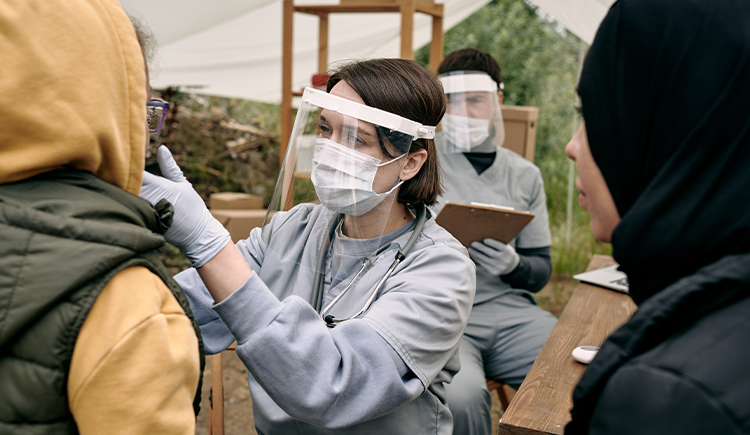
Turn on any news channel or internet feed today and the headlines are overwhelming: From the COVID-19 pandemic to extreme political divide and racial tensions and violence to the horrific effects of wars in Afghanistan and Ukraine to the destruction of the natural world. The list goes on and on.
“All over the world, people are experiencing these [and many other] collective traumas and it’s important to address them,” explains Richard F. Mollica, MD, MAR, a professor of psychiatry at Harvard Medical School who also serves as director of the Harvard Program in Refugee Trauma (HPRT) at Massachusetts General Hospital. In addition, he is director of Harvard’s Global Mental Health: Trauma and Recovery Certificate Training Program, which is a hybrid in-person and online course that trains doctors, nurses, psychiatrists, psychologists, social workers, and other public health professionals who work with populations that have experienced trauma. HPRT is considered a pioneer in creating a new field in medicine for refugee mental health over the past forty years.
Trauma in the Health Care Setting
“It’s impossible to talk to a patient about diabetes and heart disease while your building is on fire,” Mollica points out. The same is true when people have experienced trauma—either personally, such as war survivors, or when they are watching trauma unfold around them, as is happening to so many people today. “This means that doctors and nurses need to add a discussion of the collective trauma people are experiencing as part of their exams,” he says. While time constraints make this challenging within the current health system, he stresses the importance of finding creative ways to make this happen because even people who have lived through the worst-case scenarios can heal themselves with the right supports to help them. This is due to the fact that the human spirit is very resilient, stresses Eugene F. Augusterfer, LCSW, Deputy Director and Director of Telemedicine for the Harvard Program in Refugee Trauma and Harvard Global Mental Health.
The Psychology of Trauma Healing
Four decades ago, Mollica founded an area of psychology dedicated to supporting trauma survivors and helping them recover; many other providers now use the principles he developed, and he shares his expertise through Harvard’s programs to train a broad group of professionals about these concepts. For example, one of Mollica’s approaches combines Maslow’s Hierarchy of Needs with HPRT’s new H5 Model that addresses all of the layers that people experience in trauma. His work also provides a roadmap for health care professionals who seek to build their expertise in this area. In addition, he developed the Harvard Trauma Questionnaire, which is a screening tool many health care providers use to assess patients. The culmination of these efforts is to help people in crisis to find peace and healing again.
Key Elements in Addressing Trauma
HPRT explains that there are six key steps that can help guide health care professionals or others working with people who have experienced some type of trauma. These include:
- Support people in sharing their “Trauma Story.”
HPRT says that encouraging people to tell this story is really at the core of the healing process. Therefore, Mollica personally developed the concept of creating a trauma story to help people affected by trauma to be able to connect with their healers on a deep level. This approach has been so successful that many health care providers, therapists, and others who work with refugees and people impacted by trauma have adopted it as a key tenet of trauma care.
“Whether you are dealing with weather change or the effects of war, everyone needs to tell their story,” Augusterfer points out. He adds that sharing one’s experiences build an important solidarity between the healer and the people affected, which can be key to recovery.
- Create a shared experience.
The bond that you have with your patient is essential to building trust and helping them move forward. Creating a shared experience is also necessary for the patient to help protect you, as the healer, so you can do your job in the best way and not burn out.
“We need to treat our healers —doctors, nurses, social workers, and other hospital staff—as treasures that we must protect. With so much stress on medical practitioners over the past few years, many are in danger of burnout,” Mollica says. He calls attention to the real need to find ways to help them stay connected to the medical field and to their patients so they can help create positive change.
- Find beauty again.
While it may sound jarring to think about beauty in the context of an awful situation, Mollica recommends that regaining beauty is an important element of moving forward. He says, “There is no healing without beauty.” Therefore, it’s important to give agency to people who have been through trauma to find this beauty again. He further explains, “This can be accomplished by helping them to build something new, such as a new building, or to take on a new project, which can be very powerful. The beauty can also come through the shared experience of working on something with other people.”
- Develop empathy.
You need to develop your empathy to be able to understand your patient’s story and to help them be able to move forward. “Listening with deep empathy is key,” Mollica says.
“There is a saying: LUDA. This stands for listening and understanding, with deep appreciation,” Augusterfer adds. “It sounds very simple, but it’s not simple at all.” Being able to put yourself in someone else’s shoes can be extremely challenging, and in the case of someone who has been through extreme trauma, it can be very painful. But this is also a significant part of helping the patient feel heard and safe so they can begin to rebuild their lives in new and healthier ways.
- Restore dignity.
“All medical professionals are about restoring human dignity. Yet that concept is rarely used in modern medicine. When a person has metastatic breast cancer, they may feel a loss of beauty, identity, and sexuality,” Mollica says. The doctor needs to treat more than the cancer but, rather, the whole person to help restore their dignity.
- Find home.
Refugees and other people who have been through trauma need to find a place they can think of as home, where they can feel safe and secure. This is how they can find peace and joy again, according to Augusterfer. Medical providers also need to find a sense of home in the places where they work in order to feel more fulfilled in today’s challenging health care setting.
“We need to think of the medical setting as home. Yet rarely in medicine do we think that way. Even though we spend two-thirds of our working life in hospital or clinic, we rarely think of it as home,” he says. By thinking of the medical institution as home, clinicians can find more peace themselves and feel less burnout.
“Nobody goes into medicine, nursing or psychology saying, ‘I want to learn how to run a business or be a cog in a wheel,’ but that’s what medicine forces them into. That’s why people are quitting,” Augusterfer adds. This means that people who experienced trauma will have nowhere to turn. Embracing home could help to rectify the situation for both providers and survivors.
Trauma Healing and Home
Mollica and Augusterfer share an example of the power of home that truly illustrates how this can serve as a framework to help bring together all of the other elements and facilitate trauma healing.
“There are Syrian children who witnessed war atrocities and escaped to Lebanon. There, they built their own primary school, the Ghata School, with help from American University of Beruit. They helped with the design and built the school with their own hands,” Mollica describes. “The process helped to restore their dignity. They are now in a clean, safe environment, getting three meals a day with clean toilets and a garden in the school yard for the students to take care of,” he adds. They also have access to medical and mental health care in this setting.
The Ghata school model has currently been replicated in 12 locations. The results have been impressive, showing that children who have undergone extreme trauma can find healing by building their own home. In the process, they have a safe space to tell their trauma story, restore their dignity, create a shared experience, and find beauty and dignity again.
Mollica stresses that health care providers can learn from this example and use it to think about how to support their own patients in the process of trauma healing.
Written by Lisa D. Ellis
-
Resources
Sources:
- Mollica, Richard, F MD, MAR, Professor of Psychiatry, Harvard Medical School; Director, Harvard Program in Refugee Trauma, Massachusetts General Hospital
- Augusterfer, Eugene F., LCSW, Deputy Director and Director of Telemedicine, Harvard Program in Refugee Trauma and Harvard Global Mental Health.
Resources:
- HPRT website: https://hprt-cambridge.org/
- HTP Self Care website: https://hprtselfcare.org/


